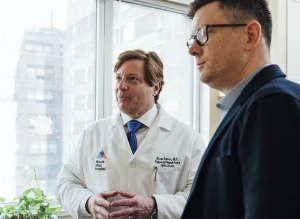Castleman disease - What is the current research?
Published 26 Oct 2020 • Updated 5 Nov 2020 • By Charlotte Avril
Castleman disease is a rare lymphoproliferative disease, meaning that it causes a disorder of the immune system by causing abnormal proliferation of lymphoid cells. These give rise to lymphocytes, which are white blood cells that defend the body against foreign bodies.
The complexity of Castleman disease lies in the fact that it is situated at the intersection of different therapeutic areas: haematology, oncology, rheumatology and virology. It is a rare disease with an uncertain cause, its clinical manifestations are diverse and it poses multiple therapeutic and diagnostic difficulties.
If you wish, you can find more detailed information on the current treatment and diagnosis of Castleman disease in the article "Castleman Disease: Everything you need to know".
Where is the current research into the as yet unknown origin of the disease? What clinical research projects are in progress and how can you, as a patient, become an actor and advance research?

What are the current research projects on Castleman disease?
Since the first description of this disease by Boston physician Dr. Benjamin Castleman in a 1954 case report and the characterisation of the multicentric form only 18 years later in 1972, much progress has been made. Whether in the differentiation of the disease subtypes, in the study of its causes with the role of interleukin 6 and HHV-8 in the immune response, or in the search for effective treatments, major advances have been made and are leading to a better understanding of the disease and its management.
However, there is still a long way to go to unravel the mysteries surrounding the causes of Castleman disease. There are five main research questions being addressed by researchers today.
What causes the over-activation of the immune system in Castleman disease?
This is one of the main questions that researchers are currently trying to answer.
One hypothesis that could answer this question is that a virus or other pathogen triggers the activation of the immune system. Once activated, the immune system releases inflammatory proteins that can cause flu-like symptoms and organ failure. The HUNT (short for Hunting for an Unknown, Novel Trigger) I, II and III studies examine lymph node samples from patients with Castleman disease to "flush" RNA (which is a kind of fingerprint) from the pathogens. If a virus is the cause, this is how the researchers will be able to confirm it.
Another hypothesis is that patients with Castleman disease may have a genetic defect that causes the immune system to function continuously and uncontrollably. A genome is the complete set of DNA (genetic material) that contains all the information necessary for a person's development and growth. The Castleman Genome Project I study (CDCN-2015-004-S) examined the full genetic material of 14 patients in 2015 to see if there was a common genetic defect in patients with Castleman disease. The technique, called "whole-genome sequencing", showed a mutation in the FAS gene in a family with several affected members. The FAS gene is known to play an important role in the function of lymphatic organs and mutations in this gene are associated with autoimmune lymphoproliferative syndrome, which may have similar characteristics to Castleman disease. Based on his work, Dr Byun, Assistant Professor at the Icahn School of Medicine at Mount Sinai, New York, is currently conducting experiments to understand how this mutation in the FAS gene may play a role in this disease.
Other studies are in progress to highlight the role of genetic mutations in the disruption of the immune system.
The FAST (Flow Cytometry And Studies of T-cells) I, FAST II, FAST III, & FAST IV studies are looking for a common mutation of an inflammatory gene in patients with Castleman disease and will also investigate the role of important immune cells called T-cells (which are the "soldiers" of the immune system).
The Somatic Mutation Search study (CDCN-2016-004-S) hypothesises that Castleman disease is caused by cancer cells. Cancer cells are normal cells that have developed mutations (changes in their DNA) over the course of life, called somatic mutations. This study is looking for cancer cells in patients' lymph nodes and will help researchers find out if they are the cause of the disease.
The identification of a genetic cause could lead to new diagnostic tools and new treatments.
Finally, another lead on the cause of hyperactivation of the immune system is being studied in the Autoantibodies in Castleman Disease project (CDCN-2018-006-S):autoantibodies. Antibodies are secreted by immune cells to fight infection, however, sometimes these antibodies attack healthy cells in the body and are then called autoantibodies. Previous tests have shown that at least 20% of patients with Castleman disease have autoantibodies in their blood. This study will look for autoantibodies in the blood of patients to see if these autoantibodies actually cause the immune system to attack healthy cells.
What type of immune cells are activated?
In Castleman disease, the immune system is activated and releases inflammatory proteins called cytokines. These cytokines cause the vital organs (liver, kidneys, bone marrow) to malfunction and shut down, and we do not know which cells or immune pathways are responsible for activating these cytokines.
The Unlock the Cell (CDCN-2015-001-R) study investigates the activated cellular pathways in Castleman disease. In this study, the researchers are examining the patients' lymph nodes using immunohistochemistry, a process that identifies certain cellular markers. A process called flow cytometry will help to determine which cell types and cell pathways are active. The PACE-LN (Pathology Analysis for Castleman Cell Type and Etiology-Lymph Node) (CDCN-2018-BLF) study is also investigating this line of research, using machine learning algorithms to identify patterns in samples and patients.
On another front, previous research has identified specific cytokines (IL-6, VEGF) that have an important role in the onset of the disease, but it remains to be determined which cells produce them and whether other cytokines are involved.
In the Identification of Cytokine Producing Cells (CDCN-2017-004-R) study, Dr. Pillai, Assistant Professor at Children's Hospital of Philadelphia and the Perelman School of Medicine (University of Pennsylvania), will examine patient lymph node tissue to identify the cells responsible for producing specific cytokines. The PACE-BM (Pathology Analysis for Castleman Cell Type and Etiology-Bone Marrow) study is also looking for immune cells and cellular pathways that can be activated, but here in the bone marrow rather than in the lymph nodes.
The identification of these cells will help to develop targeted treatments in the future.
The study of Castleman disease is particularly complicated because it is difficult to obtain samples of blood, saliva and lymph nodes, which are essential for the search for activated cell types. These samples can be stored in different parts of the world without other researchers being able to access them. The CastleBank project (a biobank dedicated to Castleman disease) will provide a central location for all samples, to which researchers will have access, making it much easier to study the disease.
Which immune system activation pathways are involved in the cells?
The Castleman Disease Collaborative Network (CDCN) recently discovered that an important immune system pathway, called the mTOR pathway, is activated in some patients and may be responsible for the activation of cytokines. The Investigation of mTOR in Castleman Disease (URF-2017, PCPM-2017) (R01-HL141408) study analyses the mTOR pathway in a larger number of patients using immunohistochemistry and flow cytometry. Initial results were presented at the 2017 meeting of the American Society of Hematology, and the efficacy of an mTOR inhibitor (sirolimus) has been shown in some patients resistant to IL-6 therapy.
In addition, the Multi-omic Profiling of iMCD-TAFRO (CDCN-2018-003-R) is examining the lymph nodes of patients with Castleman disease using several cutting-edge technologies that will study hundreds of markers to help determine the active cell types and cellular pathways involved.
Which factors are released by activated immune cells?
We are aware of some of the cytokines that play an important role in Castleman disease, however, there are still many unidentified cytokines.
The SPEED (Serum Proteomics Evaluation for Etio-pathogenesis Data) I (CDCN-2014-001-S) study measured 1129 proteins from 7 patients both during a disease flare and during remission to find out what other proteins may play a role. The SPEED II (CDCN-2016-005-S) et SPEED III (CDCN-2016-005-S) studies also measured proteins in the blood of patients with Castleman disease at different times, as well as patients with other diseases with similar characteristics (rheumatoid arthritis and Hodgkin's lymphoma in particular). Seven institutions from around the world have provided samples from these studies.
If researchers can find out which proteins are involved, it will be possible to use treatments to target these particular proteins. In addition, the identification of these proteins could provide new ways to diagnose Castleman disease.
What are the most effective treatments to stop Castleman disease?
Many treatments are still in the testing phase at the moment. These include:
- Sirolimus, cyclosporine, and mycophenolate mofetil: these are immunosuppressants often used in autoimmune diseases or to prevent the risk of transplant rejection.
- Suramin: this drug is believed to work by preventing IL-6 from attaching to and affecting lymphocytes.
- Bortezomib (Velcade): this drug is mainly used to treat multiple myeloma, some reports also suggest that it may help some people with Castleman disease.
- Rituximab (Rituxan): This medicine is used to treat certain types of lymphoma and may be helpful for people with Castleman disease.
- Silmitasertib or CX-4945: This oral medicine blocks CK2, a protein that helps certain cells grow and divide. It is still in the early stages of testing for Castleman disease.
Many different treatments have been used and are still being tested in this disease, but there have been no real guidelines either on the order in which to use these treatments or on the specifics of treatment according to the subtypes of the disease. A group of international experts has reviewed the existing published data and then made recommendations on the types of treatments that work for different types of patients. The guidelines were published in a book entitled "International Treatment Guidelines".
How can I contribute to research?
If you are living with this disease, one of the most important ways you can become involved in the fight against Castleman disease and further research is to donate samples. The Castleman Disease Collaborative Network (CDCN) collects these donations to create a biobank that will be made available to researchers. For more information, you can visit the CDCN's website.
The CDCN is a network of international initiatives aimed at accelerating research and treatment of Castleman disease. It facilitates collaboration within the global research community by mobilising resources, investing strategically in high-impact studies and supporting patients and their families.
In addition, the CDCN has created the "ACCELERATE" registry, which aims to combine medical data from hundreds of patients with Castleman disease so that researchers can discover patterns and clues that could help physicians better understand and treat the disease. Patients with Castleman disease can join the registry and provide their medical data to contribute to and advance this project. If you are interested in participating, more information can be found on the CDCN website.
You will also find all the ongoing studies, with their status, on clinicaltrials.gov, the American National Institute of Health's database of privately and publicly funded clinical studies. Some of these studies are recruiting patients to test new treatments or are calling for sample donations.
To learn more:
Don't hesitate to visit the CDCN (Castleman Disease Collaborative Network) website for more information. You can also join the Castleman disease community on Carenity to share your experience, find support and exchange information with other patients or their relatives.
Was this article helpful to you?
Feel free to share your thoughts and questions in the comments below!
Take care!
Sources :

 Facebook
Facebook Twitter
Twitter


